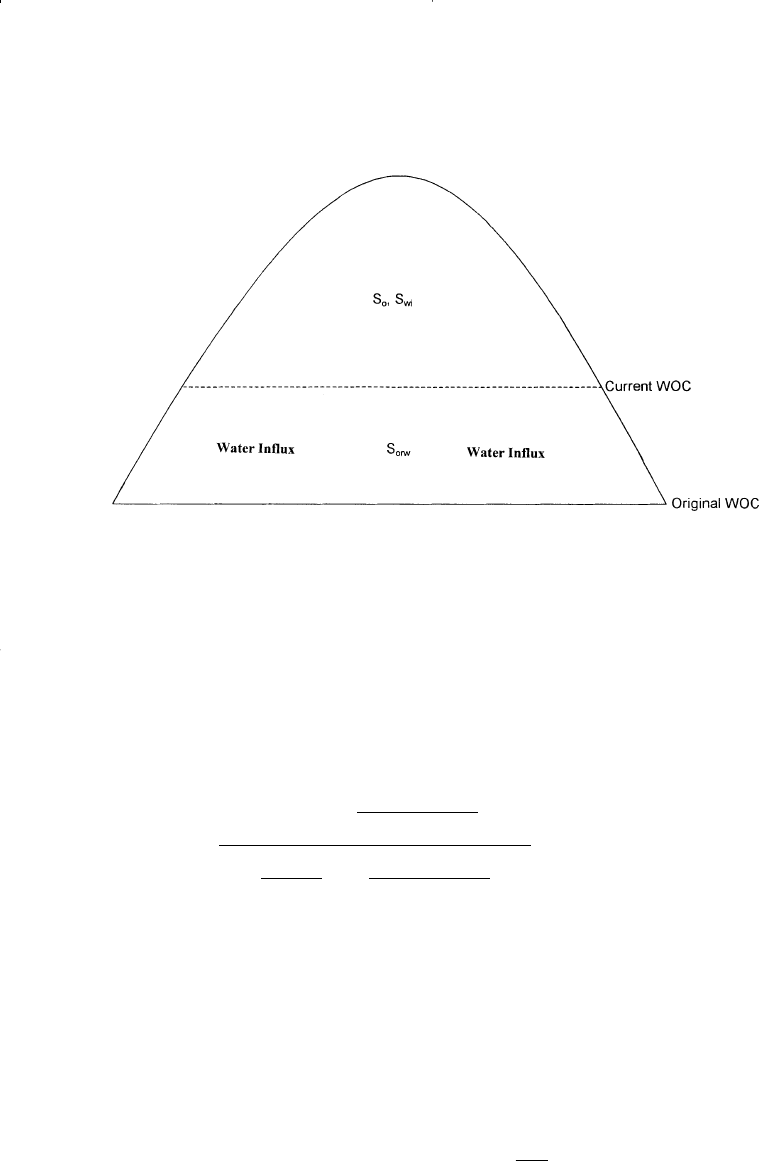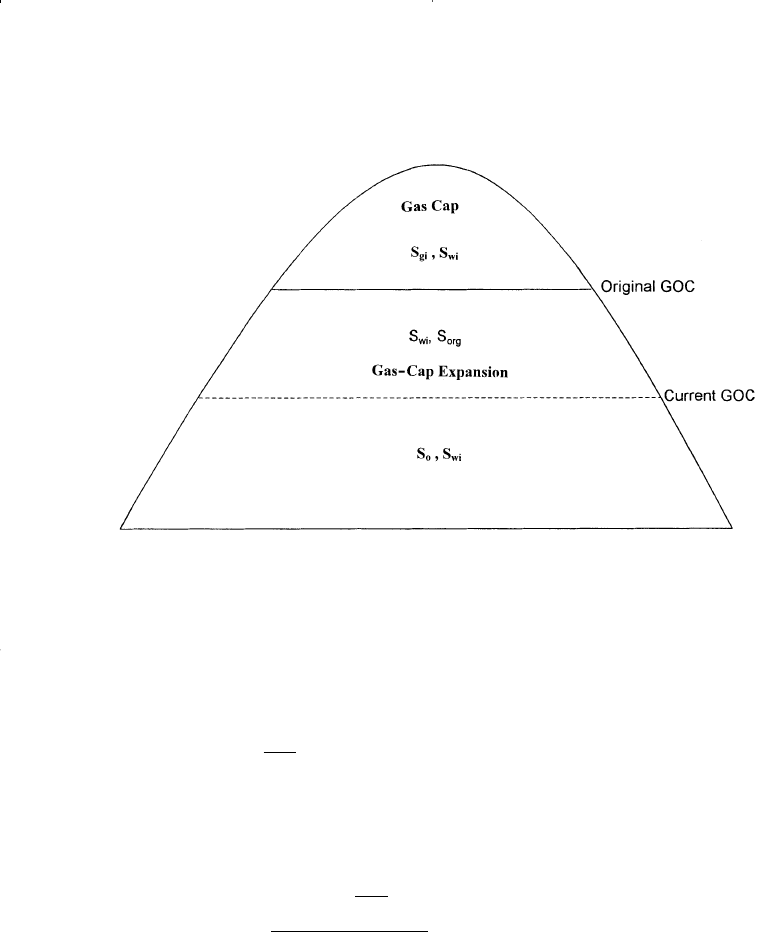Tarek Ahmed. Reservoir engineering handbook
Подождите немного. Документ загружается.


Equation 12-5 can then be approximated as:
Example 12-1
The following production data are available on a depletion-drive reser-
voir:
p GOR N
p
psi scf/STB MMSTB
2925 (p
i
) 1340 0
2600 1340 1.380
2400 1340 2.260
2100 (p
i
) 1340 3.445
1800 1936 7.240
1500 3584 12.029
1200 6230 15.321
Calculate cumulative gas produced G
p
and cumulative gas-oil ratio at
each pressure.
Solution
Step 1. Construct the following table:
p GOR (GOR)
avg
N
p
∆N
p
∆G
p
G
p
R
p
psi scf/STB scf/STB MMSTB MMSTB MMscf MMscf scf/STB
2925 1340 1340 0 0 0 0 —
2600 1340 1340 1.380 1.380 1849 1849 1340
2400 1340 1340 2.260 0.880 1179 3028 1340
2100 1340 1340 3.445 1.185 1588 4616 1340
1800 1936 1638 7.240 3.795 6216 10,832 1496
1500 3584 2760 12.029 4.789 13,618 24,450 2033
1200 6230 4907 15.321 3.292 16,154 40,604 2650
G GOR N
p avg
o
p
=
∑
()∆ (12 - 7)
788 Reservoir Engineering Handbook
Reservoir Eng Hndbk Ch 12 2001-10-25 16:04 Page 788

The Reservoir Saturation Equations
The saturation of a fluid (gas, oil, or water) in the reservoir is defined
as the volume of the fluid divided by the pore volume, or:
S
o
+ S
w
+ S
g
+ 1.0 (12 -11)
Consider a volumetric oil reservoir with no gas cap that contains N
stock-tank barrels of oil at the initial reservoir pressure p
i
. Assuming no
water influx gives:
S
oi
= 1 − S
wi
where the subscript i indicates initial reservoir condition. From the defin-
ition of oil saturation:
or
If the reservoir has produced N
p
stock-tank barrels of oil, the remain-
ing oil volume is given by:
remaining oil volume = (N − N
p
) B
o
(12-13)
pore volume
NB
S
oi
wi
=
−1
(12 -12)
1−=S
NB
pore volume
wi
oi
S
gas volume
pore volume
g
= (12 -10)
S
water volume
pore volume
w
= (12 - 9)
S
oil volume
pore volume
o
= (12 - 8)
Predicting Oil Reservoir Performance 789
Reservoir Eng Hndbk Ch 12 2001-10-25 16:04 Page 789

Substituting Equations 12-13 and 12-12 into Equation 12-8 gives:
or
S
g
= 1 − S
o
− S
wi
(12-16)
Example 12-2
A volumetric solution-gas-drive reservoir has an initial water satura-
tion of 20%. The initial oil formation volume factor is reported at 1.5
bbl/STB. When 10% of the initial oil was produced, the value of B
o
decreased to 1.38. Calculate the oil saturation and gas saturation.
Solution
From Equation 12-5
It should be pointed out that the values of the relative permeability
ratio k
rg
/k
ro
as a function of oil saturation can be generated by using the
actual field production as expressed in terms of N
p
, GOR, and PVT data.
The proposed methodology involves the following steps:
Step 1. Given the actual field cumulative oil production N
p
and the PVT
data as a function of pressure, calculate the oil and gas saturations
from Equations 12-15 and 12-16, i.e.:
S
S
o
g
=− −
=
=− − =
(.)(.)
.
.
.
...
102101
138
150
0 662
1 0 662 0 20 0 138
SS
N
N
B
B
owi
p
o
oi
=− −
()1 1 (12 -15)
S
NN B
NB
S
o
po
oi
wi
=
−
−
()
1
(12 -14)
790 Reservoir Engineering Handbook
Reservoir Eng Hndbk Ch 12 2001-10-25 16:04 Page 790

Step 2. Using the actual field instantaneous GORs, solve Equation 12-1
for the relative permeability ratio as:
Step 3. Plot (k
rg
/k
ro
) versus S
o
on a semilog paper.
Equation 12-15 suggests that all the remaining oil saturation be distrib-
uted uniformly throughout the reservoir. If water influx, gas-cap expan-
sion, or gas-cap shrinking has occurred, the oil saturation equation, i.e.,
Equation 12-15, must be adjusted to account for oil trapped in the invad-
ed regions.
Oil saturation adjustment for water influx
The proposed oil saturation adjustment methodology is illustrated in
Figure 12-4 and described by the following steps:
Step 1. Calculate the pore volume in the water-invaded region, as:
W
e
− W
p
B
w
= (P.V)
water
(1 − S
wi
− S
orw
)
Solving for the pore volume of water-invaded zone (P.V)
water
gives:
where (P.V)
water
= pore volume in water-invaded zone, bbl
S
orw
= residual oil saturated in the imbibition water-
oil system.
(. )PV
WWB
SS
water
epw
wi orw
=
−
−−1
(12 -18)
k
k
GOR R
B
B
rg
ro
s
gg
oo
=−
()
µ
µ
(12 -17)
SS
N
N
B
B
SSS
owi
p
o
oi
gowi
=− −
=− −
()11
1
Predicting Oil Reservoir Performance 791
Reservoir Eng Hndbk Ch 12 2001-10-25 16:04 Page 791

Step 2. Calculate oil volume in the water-invaded zone, or:
volume of oil = (P.V)water S
orw
(12 - 19)
Step 3. Adjust Equation 12-14 to account for the trapped oil by using
Equations 12-18 and 12-19:
Oil saturation adjustment for gas-cap expansion
The oil saturation adjustment procedure is illustrated in Figure 12-5
and summarized below:
Step 1. Assuming no gas is produced from the gas cap, calculate the net
expansion of the gas cap, from:
Expansion of the gas cap = m N B (12 - 21)
oi
B
B
g
gi
−
1
S
NNB
WWB
SS
S
NB
S
WWB
SS
o
po
epw
wi orw
orw
oi
wi
epw
wi orw
=
−−
−
−−
−
−
−
−−
()
1
11
(12 - 20)
792 Reservoir Engineering Handbook
Figure 12-4. Oil saturation adjusted for water influx.
Reservoir Eng Hndbk Ch 12 2001-10-25 16:04 Page 792

Step 2. Calculate the pore volume of the gas-invaded zone, (P.V)
gas
, by
solving the following simple material balance:
or
where (P.V)
gas
= pore volume of the gas-invaded zone
S
org
= residual oil saturation in gas-oil system
Step 3. Calculate the volume of oil in the gas-invaded zone.
oil volume = (P.V)
gas
S
org
(12-23)
(. )PV
mNB
B
B
SS
gas
oi
g
gi
wi org
=
−
−−
1
1
(12 - 22)
mNB
B
B
PV S S
oi
g
gi
gas wi org
−
=−−11(. ) ( )
Predicting Oil Reservoir Performance 793
Figure 12-5. Oil saturation adjustment for gas-cap expansion.
Reservoir Eng Hndbk Ch 12 2001-10-25 16:04 Page 793

Step 4. Adjust Equation 12-14 to account for the trapped oil in the gas
expansion zone by using Equations 12-22 and 12-23, to give:
Oil saturation adjustment for combination drive
For a combination-drive reservoir, i.e., water influx and gas cap, the
oil-saturation equation as given by Equation 12-14 can be adjusted to
account for both driving mechanisms, as:
Oil saturation adjustment for shrinking gas cap
Cole (1969) points out that the control of the gas cap size is very often
a reliable guide to the efficiency of reservoir operations. A shrinking gas
cap will cause the loss of substantial amount of oil, which might other-
wise be recovered. Normally, there is little or no oil saturation in the gas
cap, and if the oil migrates into the original gas zone there will necessari-
S
NNB
mNB
B
B
S
SS
WWS
SS
NB
S
mNB
B
B
SS
WWB
SS
o
po
oi
g
gi
org
wi org
e p orw
wi orw
oi
wi
oi
g
gi
wi org
epw
wi orw
=
−−
−
−−
+
−
−−
−
−
−
−−
+
−
−−
()
()
1
11
1
1
11
(12 - 25)
S
NNB
mNB
B
B
SS
S
NB
S
mNB
SS
B
B
o
po
oi
g
gi
wi org
org
oi
wi
oi
wi org
g
gi
=
−−
−
−−
−
−
−−
−
()
1
1
11
1
(12 - 24)
794 Reservoir Engineering Handbook
Reservoir Eng Hndbk Ch 12 2001-10-25 16:04 Page 794

ly be some residual oil saturation remaining in this portion of the gas cap
at abandonment. The magnitude of this loss may be quite large, depend-
ing upon the:
• Area of the gas-oil contact
• Rate of gas-cap shrinkage
• Relative permeability characteristics
• Vertical permeability.
A shrinking gas cap can be controlled by either shutting in wells which
are producing large quantities of gas-cap gas or by returning some of the
produced gas back the gas cap portion of the reservoir. In many cases, the
shrinkage cannot be completely eliminated by shutting in wells, as there is
a practical limit to the number of wells that can be shut in. The amount of
oil lost by the shrinking gas cap can be very well the engineer’s most
important economic justification for the installation of gas return facilities.
The difference between the original volume of the gas cap and the vol-
ume occupied by the gas cap at any subsequent time is a measure of the
volume of oil that has migrated into the gas cap. If the size of the original
gas cap is m N B
oi
, then the expansion of the original free gas resulting
from reducing the pressure from p
i
to p is:
Expansion of the original gas cap = m N B
oi
[(B
g
/B
gi
) − 1]
where m N B
oi
= original gas-cap volume, bbl
B
g
= gas FVF, bbl/scf
If the gas cap is shrinking, then the volume of the produced gas must
be larger than the gas-cap expansion. All of the oil that moves into the
gas cap will not be lost, as this oil will also be subject to the various dri-
ving mechanisms. Assuming no original oil saturation in the gas zone,
the oil that will be lost is essentially the residual oil saturation remaining
at abandonment. If the cumulative gas production from the gas cap
is G
pc
scf, the volume of the gas-cap shrinkage as expressed in barrels is
equal to:
Gas-cap shrinkage = G
pc
B
g
− m N B
oi
[(B
g
/B
gi
) − 1]
Predicting Oil Reservoir Performance 795
Reservoir Eng Hndbk Ch 12 2001-10-25 16:04 Page 795

From the volumetric equation:
G
pc
B
g
− m N B
oi
[(B
g
/B
gi
) − 1] = 7758 A h φ (1 − S
wi
− S
gr
)
where A = average cross-sectional area of the gas-oil contact, acres
h = average change in depth of the gas-oil contact, feet
S
gr
= residual gas saturation in the shrinking zone
The volume of oil lost as a result of oil migration to the gas cap can
also be calculated from the volumetric equation as follows:
Oil lost = 7758 A h φ S
org
/B
oa
where S
org
= residual oil saturation in the gas-cap shrinking zone
B
oa
= oil FVF at abandonment
Combining the above relationships and eliminating the term 7758 A h
φ, give the following expression for estimating the volume of oil in bar-
rels lost in the gas cap:
where G
pc
= cumulative gas production for the gas cap, scf
B
g
= gas FVF, bbl/scf
All the methodologies that have been developed to predict the future
reservoir performance are essentially based on employing and combining
the above relationships that include the:
• MBE
• Saturation equations
• Instantaneous GOR
• Equation relating the cumulative gas-oil ratio to the instantaneous GOR
Using the above information, it is possible to predict the field primary
recovery performance with declining reservoir pressure. There are three
Oil lost
GB mNB
B
B
S
SSB
pc g oi
g
gi
org
wi gr oa
=
−−
−−
1
1()
796 Reservoir Engineering Handbook
Reservoir Eng Hndbk Ch 12 2001-10-25 16:04 Page 796

methodologies that are widely used in the petroleum industry to perform
a reservoir study, these are:
• Tracy’s method
• Muskat’s method
• Tarner’s method
These methods yield essentially the same results when small intervals
of pressure or time are used. The methods can be used to predict the per-
formance of a reservoir under any driving mechanism, including:
• Solution-gas drive
• Gas-cap drive
• Water drive
• Combination drive
The practical use of all the techniques is illustrated in predicting the
primary recovery performance of a volumetric solution-gas-drive reser-
voir. Using the appropriate saturation equation, e.g., Equation 12-20 for a
water-drive reservoir, any of the available reservoir prediction techniques
could be applied to other reservoirs operating under different driving
mechanisms.
The following two cases of the solution-gas-drive reservoir are consid-
ered:
• Undersaturated-oil reservoirs
• Saturated-oil reservoirs
Undersaturated-Oil Reservoirs
When the reservoir pressure is above the bubble-point pressure of the
crude oil system, the reservoir is considered an undersaturated. The gen-
eral material balance is expressed in Chapter 11 by Equation 11-15.
For a volumetric undersaturated reservoir with no fluid injection, the
following conditions are observed:
N
NB R RB W WB GB WB
BB R RBmB
B
B
Bm
Sc c
S
p
p o p s g e p w inj ginj inj wi
ooi sisg oi
g
gi
oi
wi w f
wi
=
+− −− − −
−+− + −+ +
+
−
[( )]( )
()() ()11
1
∆
Predicting Oil Reservoir Performance 797
Reservoir Eng Hndbk Ch 12 2001-10-25 16:04 Page 797
